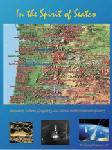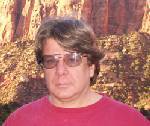
A Book Review of "In the Spirit of Seatco"
by Thom Powell...
A new book by Henry James Franzoni
 Photo left: Henry J. Franzoni, author "In the Spirit of Seatco"
Photo left: Henry J. Franzoni, author "In the Spirit of Seatco"
I just finished Henry Franzoni's long-awaited book "In the Spirit of
Seatco". It is, in a word, profound. Henry is the walking encyclopedia of the bigfoot phenomenon. He
has been flying under the radar of the modern legion of bigfoot
researchers for years and he has finally stuck his literary head up,
like Punxsutawney Phil on February 2nd, for the flesh-and-blood bigfoot
researcher to shoot at.
Henry won't mind. He tends to look disdainfully on the very idea of 'bigfoot research' as it is generally pursued by its contemporary proponents. Like a lot of us, Henry also doesn't much care for the word bigfoot in the first place. (Would you want to be named after a part of your body?) So, Henry's book advocates for use of the Indian term "Seatco" in reference to the hirsute forest people.. I think I can get used to the term Seatco, but it will take a while. Right now, 'Seatco' conjures in my twisted mind images of huge container vessels plying the waters of the lower Columbia, festooned with shipping containers stacked like cordwood, each emblazoned with giant letters that read names like "Hanjin" "Evergreen", and now, "Seatco". That's OK. I'll get over it, because the book Henry has written is immensely important. In it, Henry posits a bona fide scientific theory for what is behind the sasquatch phenomenon and he invokes multiple lines of evidence to support his unified explanation for most if not all all of the puzzling observations and experiences that are sometimes reported in association with the sasquatch phenomenon.
Most books on the bigfoot subject attempt to explain the phenomenon as a race or species of animals, and they do so by ignoring or denying the more mysterious and contradictory aspects of these enigmatic beings. A few books, like mine, acknowledge the mysterious aspects of the subject but utterly fail to explain them because the author (for example,moi) lacks the depth and breadth in their scientific background that might enable them to make sense of the more vexing aspects of the sasquatch beings.
Enter: Henry Franzoni, perhaps the most knowledgeable and educated person to ever study the sasquatch subject. Some of us have known for years that Henry was to the sasquatch subject what the Rosetta stone is to the study of ancient languages. The fact that Henry was, for so many years, averse to writing a book detailing his encyclopedic knowledge of the subject didn't bother us too much. Henry was quietly available to guys like me, Chris Murphy, Kathy Strain, and Lord know who else, who ripped off Henry's research material and insights for their own books. ( mea culpa; and I did credit Henry in the book's dedication). Meanwhile, folks like Joe Beelart, Dave Mann, Leann McCoy, Alicia Bateman, and I knew he had much more material rat-holed away in that fertile mind of his, and we are glad that Henry has finally produced what many of us I consider to be the most important 'bigfoot book' every written.
It is important because Henry's book it does a better job than any other book of offering a scientifically based explanation, albeit a pretty radical one, for the entirety of the sasquatch phenomenon. "In the Spirit of Seatco" also does several things that have never been done before. Henry's statistical analyses of place names and sighting reports are the best treatment of these data sources that have ever been done or ever could be done. Like a VanCleef diamond that is cut so perfectly the first time that no one could ever improve upon that initial work, Henry renders the most useful conclusions from the impure vat of sighting report data, taking the analysis of sighting reports to its logical conclusion. This is fantastic because it enables us to eliminate these informational equivalents of Hostess Twinkies from our malnourished intellectual diets. Through his book, Henry has rendered both BFRO's data base and John Green's data base completely irrelevant. He does the samething with his analysis of place names. He analyzes them to a logical conclusion that eliminates any future need to reexamine that data source as well. Henry reflects on early research efforts for the benefit of newcomers to the bigfoot research field. He provides fascinating recollections from the early days and his work with the likes of Dahinden, Byrne, Glickman, Titmus, Greenwell, Rines, and others. Despite his disdain for much of that which passes for 'bigfoot research,' Henry establish his 'street credibility' in this realm. He then does one better by shining considerable light on Native American perspectives. Some Indians may be horrified to learn that Henry provides more Indian information on the sasquatch than has ever before been handed over to us prying palefaces. Henry draws deeply from his secret well of professional and personal contacts in various North American tribes. Then, Henry assimilates information from his equally deep scientific background. He manifests an understanding of a broad array of relevant scientific principles, especially general physics and electrical engineering, to explain and unify virtually all the loose ends that frazzle the minds of those of us who struggle to fathom the true nature of the sasquatch phenomenon.
Here is an example: Most authors offhandedly dismiss such notions as the 'disappearing bigfoots' for fear of relegating their work to the pile of new-age-baloney books. Though my book, "The Locals" acknowledges the reality of such ideas as 'disappearing bigfoots' I, in no way, offer an explanation for this strange matter. I do identify this particular mystery as essentially an energy problem: Where and how could such beings possibly get the energy to perform such energy-intensive feats?
Henry has the answer. He provides a theoretical solution to this energy problem by stitching together a few complex scientific principles, sighting report data, and place name data. No one else on earth could have done this because no one else, anywhere, ever, could do this. Henry's combination of field experience, broad-spectrum scientific knowledge, and access to Native American culture has no match,. Nor does his keen insight that interprets the data and formulates the appropriate interpretation. Henry's explanation of this latent energy source seems to be particularly relevant as we search for a solution to the economic and energy problems that the world currently faces. Who would ever think that a 'bigfoot book' contains the best idea for the next proverbial 'Manhattan Project' that could rescue the nation if not the world from energy constraint and economic recession? Accessing the energy source Henry describes as inverse impedence of DC current seems to my limited brain to be concept that seems to affords incredible economic potential. Could the bigfoot phenomenon hold the 'keys to the kingdom' of a vast untapped power supply? Could this be the reason why the government doesn't want you to know more about the Seatco phenomenon? Here again, in my book I asked the question. In Henry's book, he answered it.
Which brings me to the one thing about Henry Franzoni's book I like best, and one thing I like the least. I really like the fact that that Henry's book makes my book, "The Locals" look timid. I like that because the most common criticism of my book is that it goes too far in giving serious consideration to the so-called 'paranormal' possibilities surrounding the bigfoot phenomenon. those who hold that view of my book, would do well to avoid all contact with "In the Spirit of Seatco." Henry's book vindicates my position by going not just light-years, but parsecs farther in his serious treatment of the oft-pooh-poohed paranormal possibilities. It gets me off the hook, but at a certain cost: it also renders my book obsolete.
Which brings me to the thing I like least about Henry's book: it's
the last word on the subject. Not only does it render previous bigfoot
books obsolete, it may also eliminates the need for any future books on
the subject. What bothers me is just that, that it's the last book on
the sasquatch subject that one will ever need to buy. Damn. I like
buying bigfoot books. I like going camping and 'searching for bigfoot.
"In the Spirit of Seatco" is more dense with information and profound in
its conclusions than any other book that has ever been written on this
subject, and likely any other book that will ever be written. That's
what bothers me. After Henry's book, there's nothing left to say.
There is no more searching for tracks, hair samples, or bigfoot
hideouts. No more sighting reports to study. Henry's book gives us the
only answers we'll ever get. It's over. Time to get a new hobby.
Bigfoot mystery: Case closed.
....Thom Powell, March 2009...
Website info for "In the Spirit of the Seatco" http://www.henryfranzoni.com/itsos.html
Back to reviews?
Back to Bigfoot Encounters Main page
Back to Newspaper & Magazine Articles
Back to Bigfoot Encounters "What's New" page
Portions of this website are reprinted and sometimes edited to fit the standards of this website
under the Fair Use Doctrine of International Copyright Law
as educational material without benefit of financial gain.
http://www4.law.cornell.edu/uscode/17/107.html
This proviso is applicable throughout the entire Bigfoot Encounters Website.